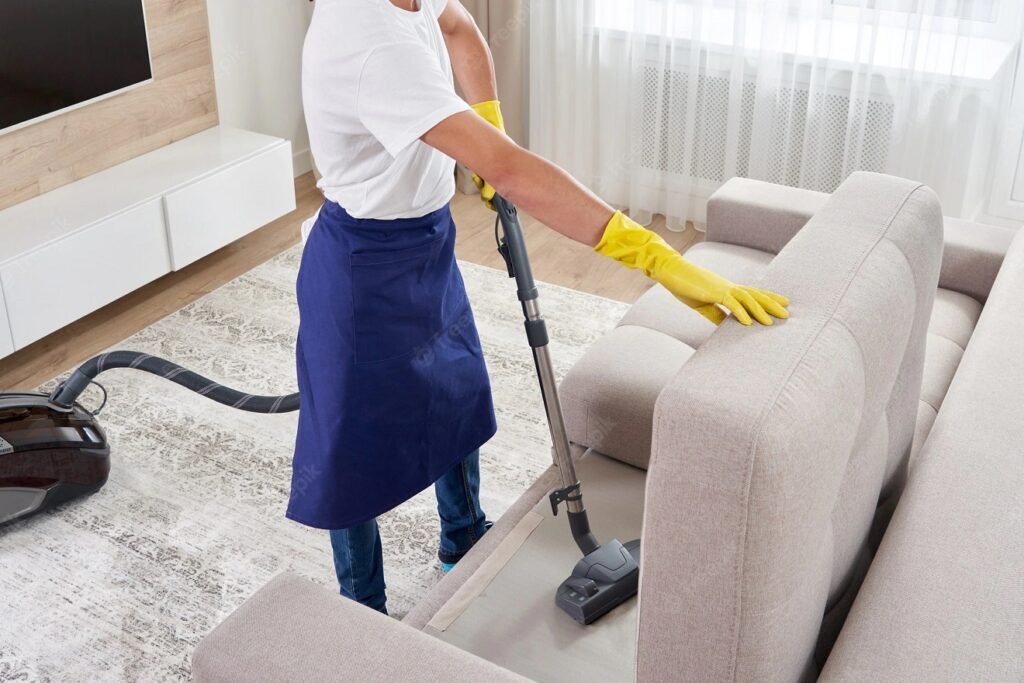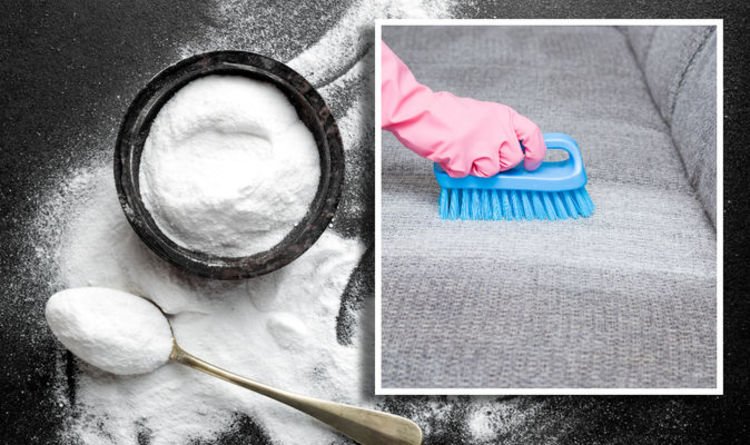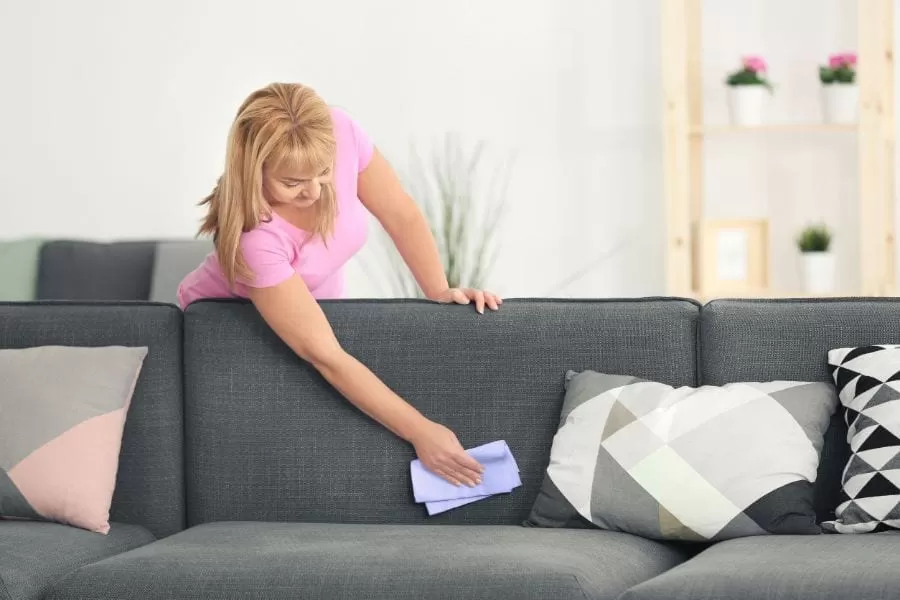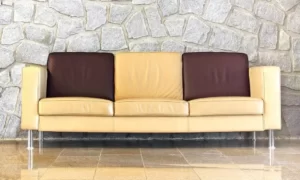Last updated on February 12th, 2024 at 12:09 am
Welcome to our thorough guide on how to clean a couch. Your settee is not only a relaxing spot but also the focal point of your living room. It accumulates grime, stains, and foul odours over time. However, with the proper techniques and a little bit of work, you can restore its attractiveness and prolong its life.
This article will guide you through the process of cleaning your sofa, discussing various varieties of fabrics and cleaning techniques. We have you covered, from vacuuming and spot cleaning to thorough cleaning and stain removal.
We will also provide you with advice on how to maintain the hygiene of your sofa over time. Prepare to transform your sofa into a new and welcoming retreat!
How to Clean a Sofa: The Basics

Photo Credit: treehouse
Cleaning a sofa is necessary to maintain its cleanliness and appearance. A systematic approach will help you accomplish optimal results without damaging the fabric, whether you’re dealing with spills, stains, or just ordinary dirt and dust. Follow these straightforward steps to begin:
Before beginning the cleaning procedure, consult the care label or manufacturer’s instructions on the sofa. To avoid mishaps, you may need to be aware of particular cleansing instructions for various types of fabric.
Collect the required cleaning supplies, including a vacuum cleaner with upholstery attachments, mild detergent, warm water, clean white cloths, a soft brush or sponge and a spray container.
Using the upholstery attachment on your vacuum cleaner, remove loose dirt, dust and detritus from the surface and crevices of the sofa. Pay special attention to the cushions and crevices.
Perform a spot test on a small, inconspicuous area before administering any cleaning solution to the entire sofa. This will aid in preventing the cleaning solution from discolouring or damaging the fabric.
For fresh stains, delicately blot the affected area with a clean, white cloth to absorb as much liquid as possible. Avoid rubbing, as it may cause the stain to extend.
For older or persistent stains, mix a mild detergent with tepid water. Apply the solution to a clean cloth and delicately dab the stained area. Using a dry cloth, absorb the excess moisture.
Depending on the type of fabric, you can either use a mild detergent solution or a specialised upholstery cleanser to clean the entire sofa.
Dilute the detergent with tepid water or follow the directions on the bottle of upholstery cleaner. Use a gentle brush or sponge to evenly distribute the cleaning solution across the sofa’s surface. Avoid soaking the fabric by working in tiny sections.
Rinse and remove excess moisture
Once the entire sofa has been cleansed, dampen a clean cloth with plain water and wipe the surface gently to remove any soap residue. Make sure that the fabric is not oversaturated.
Allow the sofa to air-dry in a well-ventilated area, out of direct sunlight, and away from heat sources. Utilise ventilation and open windows to hasten the drying process. Avoid using a hairdryer or radiator on the fabric, as excessive heat can cause irreparable damage.
After the sofa is completely dry, use a soft brush or a clean, dry cloth to restore the fabric’s texture by fluffing and brushing it. Additionally, brushing will help remove any loose grime or debris.
If your sofa has acquired unpleasant odours, there are a few easy solutions you can attempt. Sprinkle baking soda liberally across the entire sofa’s surface and allow it to remain for several hours or overnight.
Baking soda is an excellent odour absorber

Photo Credit: express
Once the time has expired, thoroughly vacuum the sofa to remove the baking soda. Additionally, you can neutralise odours by placing a bowl of activated charcoal or coffee grounds on the sofa. In addition, if the sofa has removable cushion coverings, confirm that they are machine-washable and adhere to the manufacturer’s cleaning instructions.
Consider using a fabric protector to prevent future stains and dirt accumulation on the sofa. Fabric protectors create a barrier that repels liquids and facilitates the cleanup of accidents.
Apply the fabric protector according to the product’s instructions and equally across the sofa’s surface. Test it first on a small, inconspicuous area to assure compatibility with the fabric.
Consider employing a professional upholstery cleaning service if your sofa requires a deeper cleaning or has stubborn stains that you cannot remove.
They have the knowledge and equipment necessary to eliminate stubborn stains and revitalise your sofa. To discover a trustworthy service provider, conduct research on local professionals and read reviews.
Maintain the appearance of your sofa by incorporating routine maintenance into your cleansing routine. Regularly hoover the sofa to remove grime, crumbs and pet hair.
Wipe up accidents with a clean cloth immediately to prevent them from settling. Consider periodically rotating the cushions to distribute wear and strain evenly.
Adopt preventive measures
To reduce the frequency of thorough cleaning, promote healthy practices around the sofa. Discourage eating and drinking on the settee, particularly messy or stain-causing foods and beverages.
Use throws or slipcovers to safeguard the sofa against stains and pet fur. Additionally, placing a blanket or cover on the settee can shield it from direct sunlight, which can cause the fabric to fade.
How to Clean a Sofa: Different Upholstery Materials

Photo Credit: prohousekeepers
Sofas are available with a variety of upholstery materials, each of which requires unique cleaning procedures. Let’s examine the most prevalent varieties of upholstery and how to effectively clean them:
Fabric Upholstery
Fabric sofas are renowned for their adaptability and comfort, but they must be cleaned with special attention. As opposed to leather or synthetic materials, fabric upholstery may be more susceptible to staining and soil accumulation. The following is a step-by-step guide on how to clean and maintain fabric upholstery:
Check the sofa’s care label or any manufacturer’s instructions that are specific to your fabric. This will provide you with essential information regarding the recommended cleansing methods and any precautions you must take.
To prevent dirt and dust from settling into the fabric, routinely hoover your sofa with a soft brush. Pay close attention to the cushions, cracks, and detachable covers. This will help remove errant debris and maintain the upholstery’s appearance.
Immediately address spills and stains with spot washing. To absorb any liquid, blot the afflicted area with a clean, white cloth or paper towel.
Avoid rubbing, as this may disseminate the stain. For specific varieties of stains, consult a guide on stain removal or the manufacturer’s instructions.
Before applying any cleaning solution to your fabric upholstery, conduct a patch test in an inconspicuous or hidden area.
This will ensure that the cleansing product does not discolour or damage the surface. Before proceeding, wait for the test area to dry and evaluate any adverse effects.
Choose an appropriate cleaning method: Depending on the fabric type and extent of soiling, you have a variety of cleaning methods to choose from. Common alternatives include:
Mix a small volume of mild detergent with water to create a solution for water-based cleaning. Using a delicate cloth or sponge, apply the solution to the stained area in a gentle manner. To eradicate the dirt, blot the area and then rinse with a clean, damp cloth.
Solvents for dry cleaning: Certain fabrics may require solvents for dry cleanings, such as rubbing alcohol or specialised fabric cleansers.
Following the product instructions precisely, apply the solvent to the stain with a clean cloth or sponge. Gently blot the area and allow it to air dry.
Allow for appropriate drying: Ensure that your fabric upholstery is thoroughly dried after cleaning. Use fans or open windows to improve air circulation. To prevent potential damage or soiling, refrain from sitting on the sofa until it is entirely dry.
Consider applying a fabric protectant or stain guard to your upholstery according to the specifications provided by the manufacturer. This can assist in repelling spills and stains, making subsequent cleanings simpler.
In addition, routinely fluff and rotate the cushions to prevent uneven wear and preserve the appearance of the sofa.
Leather Upholstery
Leather couches are renowned for their enduring elegance and opulent appearance. To maintain their appearance and ensure their durability, appropriate maintenance and cleaning are required. Follow these methods to clean a leather sofa effectively:
Start by dusting the sofa with a gentle, dry cloth or the soft brush attachment of a vacuum cleaner. This phase involves the removal of any loose dirt or debris.
Examine the sofa for spills and stains. Examine the sofa for any spillage and stains. If you discover any, you must address them immediately to prevent them from penetrating the leather.
Choose an appropriate cleaning solution. Based on the variety of leather, choose an appropriate cleaning solution. For protected or pigmented leather, you can use a moderate soap or leather cleaner.
For specific cleaning instructions on unfinished or aniline leather, it is best to consult a professional or the manufacturer.
Before applying the cleaning solution to the entire sofa, it should be tested on a tiny, inconspicuous area. This step ensures that the leather is not discoloured or damaged by the solution.
To clean leather, dilute the cleaning solution in accordance with the directions and apply it to a delicate cloth.
Using small, circular motions and focusing on one section at a time, clean the leather with care. Avoid excessive scouring and the use of harsh brushes, which can cause surface damage to the leather.
Create a substance by combining baking soda and water to remove stains that are difficult to remove.
Apply the paste to the stain, rub it in gently, and allow it to remain for several hours or overnight. Remove the paste with a moistened cloth and apply a leather conditioner to the affected area.
Eliminate excess moisture: After cleaning the sofa, wipe it down with a clean, damp cloth to eliminate any cleaning solution or residue left behind.
Leather requires regular conditioning and moisturising to maintain its pliability and prevent drying and splitting. Follow the manufacturer’s instructions when applying leather conditioner. This phase restores the leather’s moisture and protects it from damage.
Buffing and drying: Gently burnish the leather with a clean, dry cloth. This step improves the sofa’s sheen and texture. Allow the sofa to dry naturally in the absence of direct heat sources or sunlight.
To preserve the attractiveness of the leather, dust the sofa frequently, wipe up any spills immediately, and condition it every few months. Avoid exposing the settee to direct sunlight or heat, as this may cause the leather to fade or dry out.
Synthetic Upholstery

Photo Credit: myfabricconnection
Durable and stain-resistant synthetic upholstery materials, such as microfiber or polyester composites, are favoured.
Cleaning synthetic upholstery is relatively simple, and with these simple guidelines, you can maintain the cleanliness of your synthetic upholstered furniture:
Regular vacuuming: To begin, vacuum your synthetic upholstery with a gentle brush attachment on a regular basis. This will assist in removing loose grime, dust, and pet hair from the surface.
Spot cleaning: For minor stains or spills, blot the affected area with a clean, white cloth immediately. Rubbishing can push stains deeply into the fabric.
Using a mixture of mild detergent and water, gingerly blot the stain from the outside in. Using a clean cloth, absorb the moisture by blotting.
Depending on the levespecialisedor stains, you may need to perform a thorough cleaning on your synthetic upholstery. Consult the manufacturer’s cleaning instructions for specific recommendations.
In general, a cleansing solution can be created by combining mild detergent with warm water. Apply the solution to the upholstery using a delicate brush or sponge and circular motions.
Care should be taken not to oversaturate the fabric. Afterwards, eliminate any residue with a clean, damp cloth.
Permit the upholstery to air dry thoroughly. Avoid direct heat and sunlight, as they may cause discolouration and atrophy. Utilise ventilation and open windows to expedite the drying process.
Use a gentle brush to restore the fabric’s texture once it has dried. This will help to remove any loose grime or debris and maintain the upholstery’s appearance.
Consider using furniture coverings or throws to secure your synthetic upholstery from spills and stains in order to maintain its cleanliness. In addition, prohibit eating or imbibing on the furniture, especially with substances that can stain.
Frequently Asked Questions
How Often Should I Clean My Sofa?
Cleaning your sofa at least twice a year is advised. However, if you have pets or allergies, you may need to clean more frequently.
Can I Use Bleach To Clean My Sofa?
No, bleach is too abrasive for most upholstery fabrics and can discolour or damage them. Use gentle cleaning products and adhere to the manufacturer’s instructions.
Can I Steam Clean My Sofa?
Certain upholstery materials can be cleaned effectively with steam. However, it is imperative to first consult the manufacturer’s instructions, as some fabrics may not be suitable for steam cleaning.
How Can I Remove Pet Hair From My Sofa?
To remove pet hair, use a lint roller, a wet rubber glove, or masking tape with the adhesive side facing your hand. Press and roll gently over the surface to collect the hair.
What Should I Do If My Sofa Gets Mouldy?
If you detect mould on your sofa, you must take immediate action. Consult a professional upholstery cleaner who can remove and treat mould safely.
Can I Hire A Professional Sofa Cleaning Service?
Yes, professional sofa cleaning services provide thorough cleaning techniques and specialised equipment to revitalise and clean your sofa. Consider hiring a professional to clean your sofa if it requires extensive cleaning or if you are uncertain of the best method.
Bottom Line
Congratulations on concluding our in-depth guide on sofa cleaning! We trust this article has provided you with helpful information and suggestions for keeping your sofa in pristine condition.
You can effectively remove grime, stains, and odours from your cherished furniture by following detailed instructions and employing the appropriate cleaning techniques.
Before applying any cleaning solution to the entire sofa, remember to test it on a tiny, inconspicuous area.
Regular maintenance, such as vacuuming and spot cleaning, will help prevent the accumulation of grime and preserve the sofa’s cleanliness over time.
By devoting a small amount of time and energy to sofa cleaning, you can guarantee a clean, inviting, and hygienic seating area for you and your family. Enjoy your spotless, comfortable couch!
















